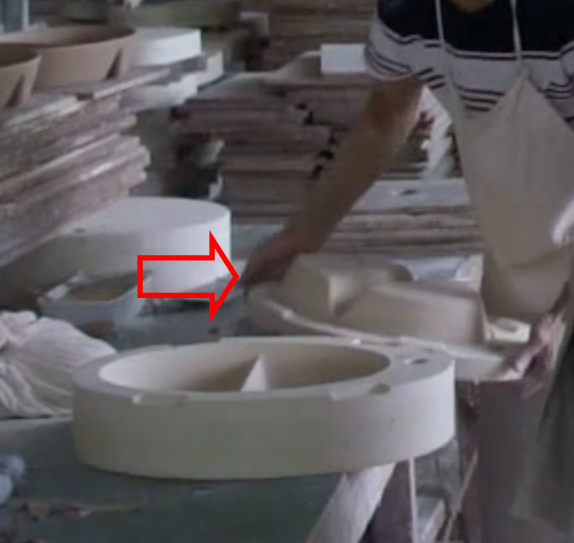Pressing
Traditional pressure pressing in porcelain production
Compression moulding of flat parts
This section deals with the traditional pressing of porcelain. This production method is suitable for both flat parts (e.g. plates) and hollow parts (bowls) and is used for all items that cannot be produced by the considerably more favourable method of jiggering (turning in hollow parts) or rolling (rolling over flat parts). This applies to asymmetrical, rectangular and square porcelain items.
The liquid porcelain mass - the so-called slip - is pressed into a tower via pressure hoses or pipes, in which several moulds are stacked on top of each other. The mass makes its way from mould to mould from bottom to top and fills the two-part "negative moulds" with the porcelain mass one after the other. These press towers contain several moulds stacked on top of each other and are held in place with large threaded presses.
Such press moulds are the most expensive, largest and heaviest plaster moulds in porcelain production. While one working mould is sufficient for turning moulds, two parts have to be made as the upper and lower part for pressing moulds. This explains the considerable price difference between a round plate and a square plate of the same size.
While this type of production is now rather rare in Germany and has been replaced by automatic compression moulding, hollow and flat parts are produced extremely efficiently worldwide using the compression moulding method. The working moulds for pressing are predominantly created as plaster moulds.

Compression moulding of hollow parts
The principle of production is basically the same as the production of flat parts and differs only in the interior of the compression mould. Whereas in the compression moulding of flat parts, the mould is completely filled with slip,

the shape of the bowl protrudes from the plaster mould like a stamp (see "arrow" above). Only a minimal filling space remains between the upper part and the lower part, which represents the desired wall thickness of the hollow part - after shrinkage. In contrast to flat part pressing, the slip is pressed through this thin cavity until the cavity is completely filled. The slurry moves in both directions of the mould - like two crawling snakes - until they meet at the connection point - diagonally to the inlet point - and close the shell body.
Pressure-pressed hollow parts can also be recognised - as above - by the small bulge or unevenness on the adjusting ring, which remains visible as a sharp edge if insufficient care is taken before firing due to inadequate fettling - or after firing due to insufficient polishing. Furthermore, under very unfavourable circumstances, undesirable seams may form on the hollow part body.
Pressure presses & flat floors
Pressure-pressed items with a flat, unglazed base require extremely careful finishing, as the inlet point of the porcelain paste has a markedly sensitive influence on stability and use on sensitive surfaces. Basically, press moulded items with a flat base should be avoided as far as possible in order to prevent later complaints. Unfortunately, this is often not possible with bowls and plates with rising walls.
